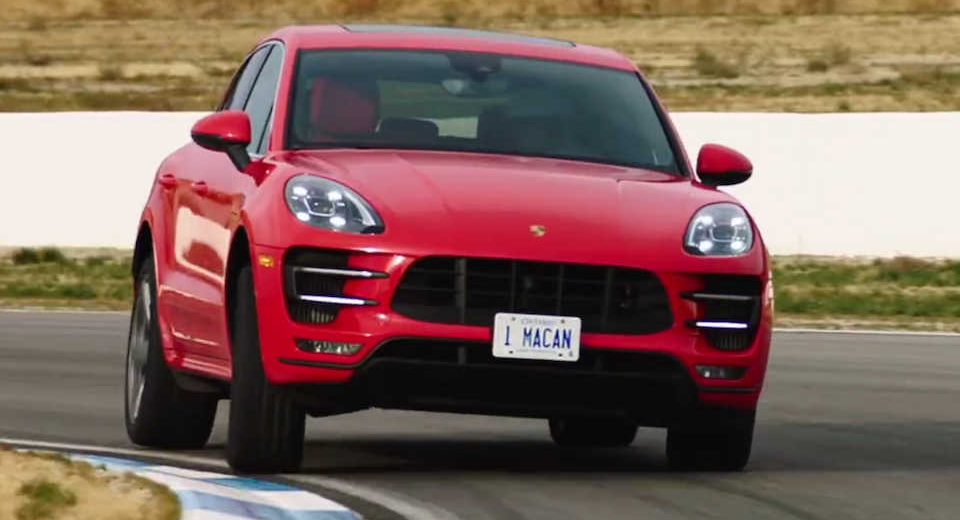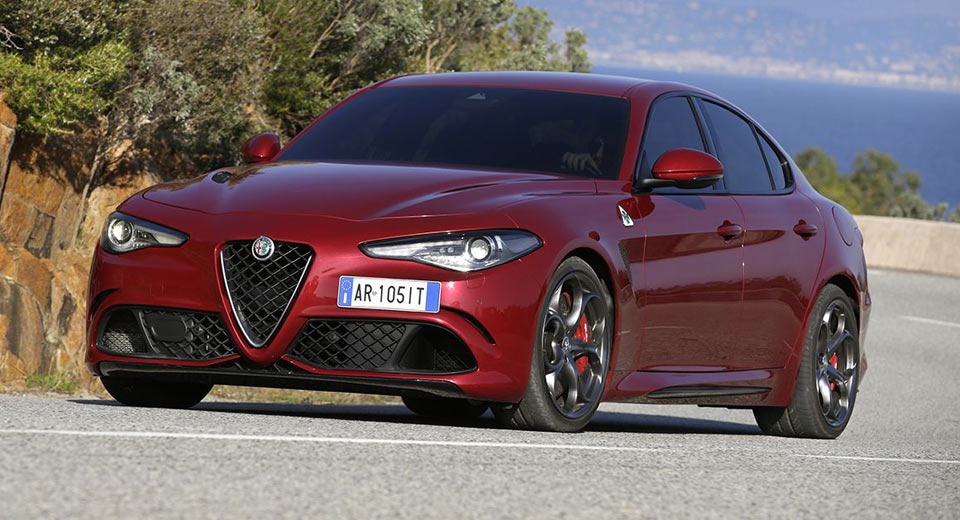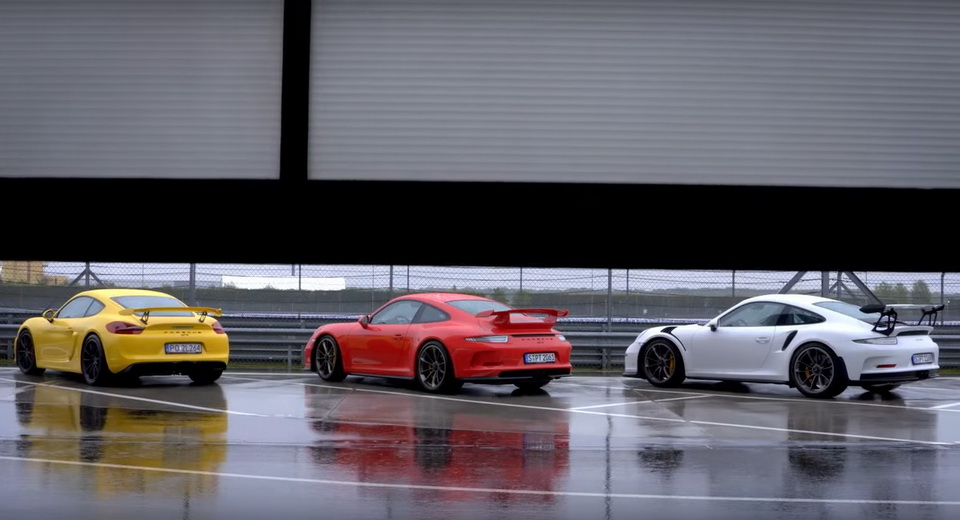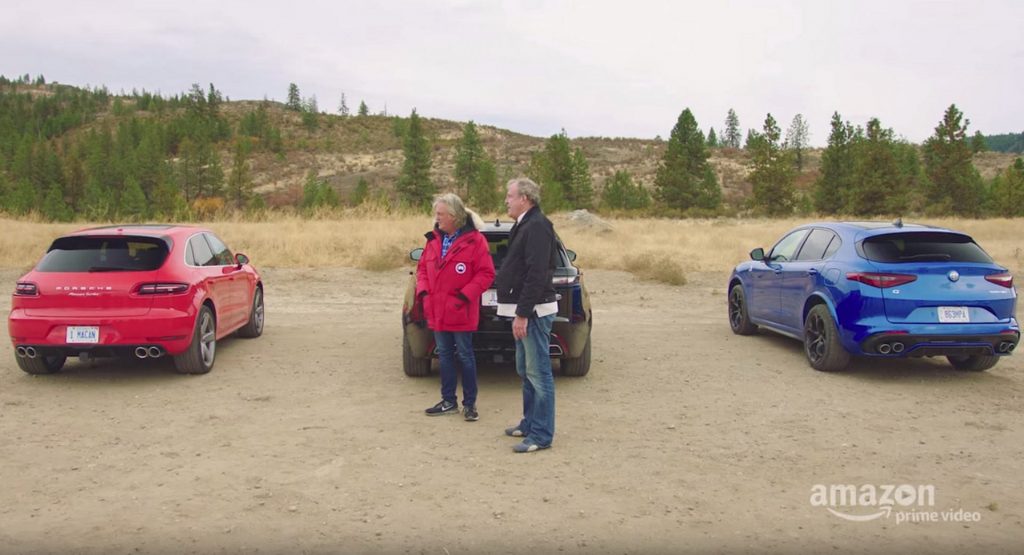When someone writes a story, they must have an angle – and the same goes for automotive journalists when they test a car, or else they might just copy the official press kit and call it a day.
In episode 10 of season 2, The Grand Tour trio took three performance crossovers – the Porsche Macan, Alfa Romeo Stelvio and Range Rover Velar, and made them jump through a few hoops. They all failed miserably. Yet, it wasn’t entirely their fault; it was Clarkson and Co’s angle that made the result a foregone conclusion.
Now, I’m not a huge fan of SUVs, crossovers, SAVs or whatever else automakers want to call them. Never owned one, probably never will: I don’t like off-roading, so I’ve got no use for even the most capable of them. In fact, I’m a sports car fan and currently in the process of finding one that will replace my dead RX-8 (long story – maybe I’ll recount it some other time).
I like my driving position to be low, the steering direct and full of feel, the gearbox a manual with as short a throw as possible, and the drive directed to the rear wheels. Don’t care much about cupholders, the latest 3,999 Watt audio system or a posh badge; what I want is a car that handles and tells me exactly what it’s doing whether the speedo is reading 50 or 150. You get the gist…
I also dig The Gran Tour and have been watching the trio on Top Gear since, well, time immemorial. Yet they are notorious for doing things in a different way and that has worked to their advantage. At some point, TG grew far beyond a show for car boffins; instead, it became mostly an entertaining show that happened to feature cars, most of them cool, in it. And it sure was a blast.
The guys also enjoy going against the tide. Since new car buyers are flocking to crossovers, they chose to go the other way. While they were right in many things, their angle was such that it didn’t do the models tested justice – and here’s why.
The track test

Have you ever taken your car to a track day? If you have, then you know that, at the end of the session, you’d better have a fresh set of tires and brake pads ready and waiting, for the ones you entered the track with are now pretty useless. And that’s if everything goes well and you don’t miss a corner and get into the gravel, nudge a barrier or, even worse, another car.
Most hardcore sports car owners don’t really take their rides to the track that much: if you had, say, a Cayman GT4 or 911 GT3, how many times would you subject it to such a drill?
My guess is you’d rather go out in search of a twisty mountain road to get your kicks much more often and if you could afford it, have a dedicated track car for enjoying in a circuit. Plus, comparing an M4 CS to any SUV on track and saying the former is slower is like complaining that you can’t put four people in an MX-5.
The “off-roading” test

At the launch of the second-gen Mercedes ML, the company had prepared an off-road test track for us that I highly doubted the German luxury SUV had any chance of traversing without getting stuck or, even worse, flipping over.
First, we sampled the car fitted with the optional off-road pack and it performed superbly. Then, we did the exact same thing with the standard version that lacked this pack – and it, too, passed the test, albeit with a bit more effort on our part.
Let me tell you, there’s no way an ML (or Range Rover, X5 etc.) owner in their right minds would go anywhere near such a location; this was way too extreme and purely created to showcase that the new ML didn’t lose its off-road mojo despite being good to drive on the road (its predecessor was, at best, a dud on tarmac).
The Grand Tour’s stunt with the horse was funny, but not really useful to draw any conclusions.
The practicality test

I have two kids and two dogs. I also used to take the former (the dogs came much later), plus the missus, on holiday for a couple of weeks in the summer or some short getaways whenever the circumstances (i.e. the tight schedule of the weekly publication I was working for back then) allowed it.
My first choice would be a large SUV like an Audi Q7 or a Toyota Land Cruiser, for one simple reason: their height enabled me to fill the cargo space with clothing, strollers, you name it. Especially the Land Cruiser, with the third row folded, swallowed a huge amount of kit, and there was room left for more.
Did I enjoy driving it? Nope. I just set the cruise control a around 75mph or 120 km/h and drove to our destination. The only downside was that, being powered by a petrol engine, it burned a hole in my pocket in fuel bills.
Once I tried to do the same in a well-known premium German estate. I ended up leaving lots of stuff behind but paid much less in fuel. As for the driving experience, when I’m on the motorway with the family onboard, I don’t travel at stupid speeds or try to push any car even close to its limits, because that would be moronic.
So, should I buy a crossover?

If I had to choose, I’d buy a Giulia over the Stelvio, a Cayman over the Macan and a Jag over the Range Rover. That’s because I’m a petrolhead, the kids have grown and, as I’ve mentioned before, I prefer my car to “talk” to me, not just take me from point A to point B.
Crossovers are a Jack of all trades and master of none. But you know what? Most buyers don’t really care about things about steering feel, have no idea what a heel-and-toe or a multi-link suspension is, and probably never switch off the ESP either, never mind drift their rear-wheel drive Bimmer whenever they get the chance.

Petrolheads are the exact opposite. Automakers know that and exploit it to the fullest with the GT33LM, RS9, Pizza or whatever they choose to christen their hardcore versions. They also charge dearly for reducing the weight by, say, 75 kg / 165 lbs (or the equivalent of having an average passenger on board) by using magnesium, titanium or unobtainium in the wheels’ valve caps and adding a ton of downforce at 200 mph. Which, by the way, unless you travel frequently on an Autobahn or get to a test track, you’ll never get to experience.
In much the same way, they exploit the non-petrolheads’ needs for a car that’s roomy, practical and good looking. Yes, I admit to throwing every expletive I could think of when I learned Porsche would roll out a VW-based SUV, but it did save the company. Didn’t like the first Continental GT, too, because I couldn’t stand to see Skoda switches on a Bentley (thankfully, they fixed that), and was happy as a clam riding shotgun in a Radical at the Ascari circuit even though the conditions were far from ideal.
I also sincerely hope Ferrari changes its mind and doesn’t make a crossover, because that will, in my eyes, tarnish the brand’s image. For me, the Prancing Horse is associated with old Enzo and his black glasses, Gilles Villeneuve driving the wheels off the Scuderia’s F1 cars, the timeless excellence of the F40, Michael Schumacher winning back-to-back championships, the exhaust noise of a naturally aspirated V8 or V12 and much, much more. I feel the same about the Urus; a saloon or shooting brake would be much more fitting to Lamborghini’s image than an SUV despite the precedent set long ago by the LM002.

You know what? I belong in a minority which, I’m sad to say, seems to be shrinking by the day. For example, I admire Elon Musk for creating Tesla, but I want a car to stir my soul, and no matter how fast it may be, a Model S does its job without a soundtrack to match. A Mustang GT350R might be inferior in almost every measurable aspect, but I’d choose it over a Model S each and every day and twice on Sundays because it’s fun!
Like I said, though, I’m a minority. Now, any suggestions for an affordable RWD car, please?



